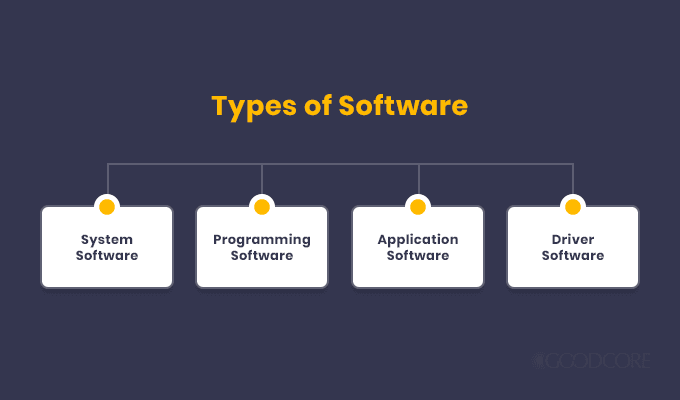So you want to know about the major types of software, huh? Well, you’re in the right place. In this article, we’ll be taking a closer look at the different categories of software that play a crucial role in our everyday lives. From operating systems that power our devices to productivity tools that help us get things done, we’ll cover it all. So sit back, relax, and let’s dive right in! When it comes to software, there are several major categories that encompass a wide range of applications and programs. From the foundational system software to the wide array of application software, each type serves a specific purpose and plays a crucial role in the digital landscape. In this article, we will explore the major types of software, from operating systems to utility software, and delve into their functions and significance.
System Software
System software forms the backbone of any computer or device, providing the essential infrastructure and resources necessary for the operation of higher-level software. It includes operating systems, device drivers, utilities, and programming language translators.
Operating Systems
The operating system (OS) is the primary system software that manages and controls the hardware, software, and other resources of a computer. It acts as an intermediary between the user and the computer, handling input and output operations, managing memory, and providing a user-friendly interface. Popular operating systems include Windows, macOS, Linux, and Android.
Device Drivers
Device drivers are software programs that facilitate communication between the operating system and hardware devices such as printers, scanners, keyboards, and graphics cards. They translate commands from the OS into instructions that the hardware can understand and enable the proper functioning of the devices.
Utilities
Utilities are software programs that assist in managing, maintaining, and optimizing computer systems. They typically include tools for tasks such as disk cleanup, data backup, file compression, and system optimization. Examples of utility software include antivirus programs, disk cleanup software, and backup software.
Programming Language Translators
Programming language translators are software tools that convert human-readable code written in programming languages into machine-readable code that can be executed by the computer. They include compilers, interpreters, and assemblers, each serving a different purpose in the software development process.
Application Software
Application software is designed for specific tasks or purposes, catering to the needs and interests of users. It includes word processing software, spreadsheet software, presentation software, database software, graphics software, media players, video editing software, web browsers, email clients, accounting software, project management software, and antivirus software.
Word Processing Software
Word processing software allows users to create, edit, and format documents. It provides features for text formatting, spell checking, grammar checking, and the ability to insert images, tables, and other elements into documents. Well-known word processing software includes Microsoft Word, Google Docs, and Apple Pages.
Spreadsheet Software
Spreadsheet software is used for organizing, analyzing, and manipulating numerical data. It provides tools for creating tables, performing calculations, creating charts and graphs, and conducting data analysis. Popular spreadsheet software includes Microsoft Excel, Google Sheets, and Apple Numbers.
Presentation Software
Presentation software enables users to create visually appealing and interactive slideshows for conveying information. It allows for the integration of text, images, videos, animations, and various visual effects to engage and inform an audience. Microsoft PowerPoint, Google Slides, and Apple Keynote are widely used presentation software.
Database Software
Database software enables the storage, organization, and retrieval of large volumes of structured data. It provides tools for creating, modifying, and managing databases, as well as querying and manipulating data. Microsoft Access, MySQL, and Oracle Database are prominent examples of database software.
Graphics Software
Graphics software is used for creating and editing visual content, including images, illustrations, and designs. It provides tools for image retouching, drawing, vector graphics, and special effects. Adobe Photoshop, CorelDRAW, and GIMP are among the popular graphics software applications.
Media Players
Media players are software programs that allow users to play and view various types of multimedia content, including audio and video files. They often include features such as playlist management, equalizers, and support for different file formats. Examples of media player software include Windows Media Player, VLC Media Player, and iTunes.
Video Editing Software
Video editing software is used for manipulating and enhancing video footage. It enables users to trim, merge, and rearrange clips, add effects and transitions, adjust color and audio, and export the final edited video. Popular video editing software includes Adobe Premiere Pro, Final Cut Pro, and iMovie.
Web Browsers
Web browsers are software applications that allow users to access and navigate the World Wide Web. They provide a means for viewing web pages, interacting with online content, and conducting internet searches. Well-known web browsers include Google Chrome, Mozilla Firefox, and Microsoft Edge.
Email Clients
Email clients are software programs that enable users to send, receive, and manage email messages. They provide features for composing and formatting emails, organizing and searching messages, and syncing with multiple email accounts. Examples of email client software include Microsoft Outlook, Gmail, and Apple Mail.
Accounting Software
Accounting software is used for managing financial transactions and records, as well as performing various accounting tasks. It provides tools for bookkeeping, invoicing, payroll management, and generating financial reports. QuickBooks, Xero, and Peachtree are popular accounting software applications.
Project Management Software
Project management software assists in planning, organizing, and tracking projects, ensuring efficient collaboration and task management. It provides features for creating project timelines, assigning tasks, monitoring progress, and facilitating communication among team members. Well-known project management software includes Microsoft Project, Trello, and Asana.
Antivirus Software
Antivirus software protects computer systems from malicious software (malware) such as viruses, trojans, and spyware. It scans files and programs for potential threats, blocks suspicious activities, and removes or quarantines detected malware. Examples of antivirus software are Norton, McAfee, and Avast.
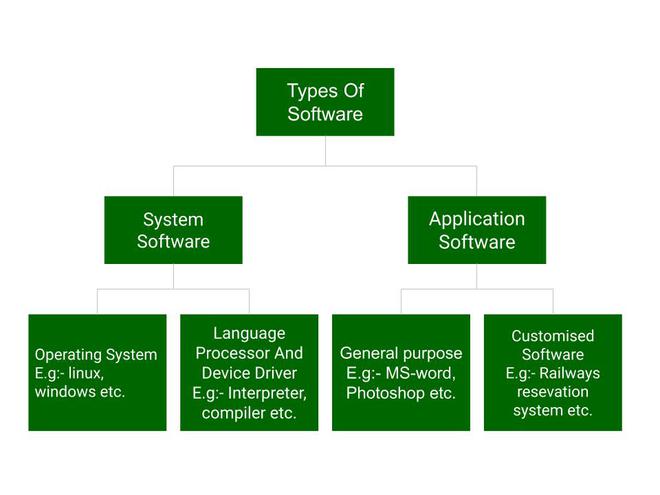
This image is property of media.geeksforgeeks.org.
Programming Software
Programming software is used by software developers and programmers to write, test, and debug software applications. It includes text editors, integrated development environments (IDEs), compilers, interpreters, and debuggers.
Text Editors
Text editors are software programs that allow developers to write and edit source code. They provide features for syntax highlighting, code completion, and customization options to enhance productivity. Popular text editors in the programming community include Sublime Text, Visual Studio Code, and Atom.
Integrated Development Environments (IDEs)
Integrated Development Environments (IDEs) are comprehensive software suites that integrate multiple tools for software development. They often include features such as code editors, debuggers, compilers, and version control systems in a single interface. Examples of IDEs include Eclipse, Visual Studio, and IntelliJ IDEA.
Compilers
Compilers are software tools that translate source code written in high-level programming languages into machine code that can be directly executed by the computer. They perform the translation process in a single step, producing executable files. Common programming language compilers include GCC for C/C++, Java compiler, and C# compiler.
Interpreters
Interpreters are software tools that execute source code line by line, without the need for prior compilation. They convert the code into machine instructions on-the-fly and execute them immediately. Interpreted programming languages, such as Python and JavaScript, rely on interpreters for their execution.
Debuggers
Debuggers are software tools that assist developers in identifying and fixing errors (bugs) in their programs. They provide features for stepping through code, setting breakpoints, inspecting variables, and monitoring program execution to isolate and resolve issues. Popular debuggers include WinDbg, GDB, and Xcode.
Enterprise Software
Enterprise software caters to the needs of large-scale organizations and facilitates their complex operations. It includes customer relationship management (CRM) software, enterprise resource planning (ERP) software, supply chain management (SCM) software, business intelligence (BI) software, human resource management (HRM) software, financial management software, and project portfolio management (PPM) software.
Customer Relationship Management (CRM) Software
CRM software helps organizations manage customer interactions, enhance customer relationships, and streamline sales and marketing processes. It provides features for storing customer data, tracking leads, managing customer communications, and analyzing customer behavior. Salesforce, Microsoft Dynamics 365, and HubSpot CRM are well-known CRM software platforms.
Enterprise Resource Planning (ERP) Software
ERP software integrates various business processes and departments into a unified system, enabling efficient resource management and planning. It encompasses functions like accounting, human resources, inventory management, and production planning. Prominent ERP software includes SAP ERP, Oracle ERP Cloud, and Microsoft Dynamics 365 ERP.
Supply Chain Management (SCM) Software
SCM software facilitates the management of the entire supply chain, from procurement to delivery. It optimizes processes such as inventory management, logistics, demand forecasting, and supplier relationship management. Notable SCM software applications include Oracle Supply Chain Management, SAP SCM, and JDA Software.
Business Intelligence (BI) Software
BI software enables organizations to gather, analyze, and visualize business data to make informed decisions. It provides tools for data mining, reporting, dashboards, and data visualization, empowering users to extract valuable insights from large datasets. Popular BI software platforms include Tableau, Microsoft Power BI, and QlikView.
Human Resource Management (HRM) Software
HRM software assists organizations in managing various HR functions, including employee onboarding, payroll processing, time and attendance tracking, and performance management. It streamlines HR processes, reduces administrative tasks, and enhances employee engagement. Notable HRM software solutions include Workday, ADP Workforce Now, and BambooHR.
Financial Management Software
Financial management software helps organizations track and manage their financial transactions, reporting, and analysis. It automates tasks such as accounts payable and receivable, budgeting, financial forecasting, and financial reporting. Prominent financial management software includes QuickBooks, Xero, and Oracle Financials.
Project Portfolio Management (PPM) Software
PPM software assists organizations in managing their projects, portfolios, and resources effectively. It provides features for project planning, resource allocation, task management, and project performance tracking. Examples of PPM software platforms are Microsoft Project Portfolio Management, Clarizen, and Planview.
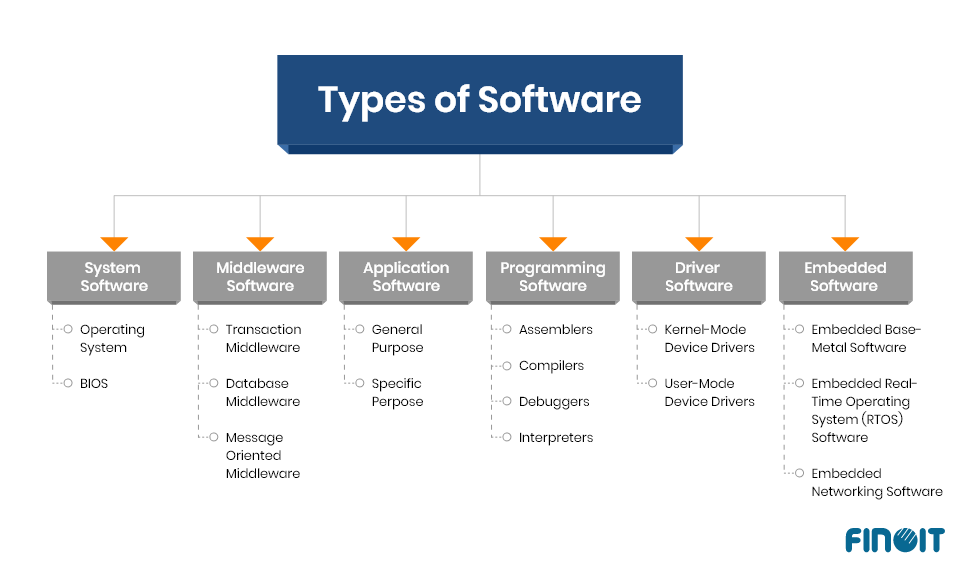
This image is property of www.finoit.com.
Embedded Software
Embedded software is specifically designed for embedded systems, which are computer systems embedded within other devices or machinery. It encompasses various industries, including automotive, aerospace, medical devices, industrial control systems, and mobile devices.
Automotive Software
Automotive software plays a crucial role in modern vehicles, enabling advanced features such as infotainment systems, navigation systems, driver assistance, and safety systems. It controls the vehicle’s various subsystems and interfaces with external devices and networks. Automotive software includes embedded software in Electronic Control Units (ECUs), as well as software for diagnostic and testing purposes.
Aerospace Software
Aerospace software is essential for the design, development, testing, and operation of aircraft and spacecraft. It includes embedded software for flight control, avionics, navigation systems, communication systems, and guidance systems. Aerospace software must meet rigorous safety and reliability standards to ensure the safety of passengers and crew.
Medical Devices Software
Medical devices software is used in various medical equipment and devices, ranging from patient monitoring systems to surgical instruments. It includes embedded software that enables the functioning and control of medical devices, as well as software for data analysis, remote monitoring, and medical imaging.
Industrial Control Systems Software
Industrial control systems software is employed in controlling and monitoring industrial processes and machinery. It provides real-time monitoring and automation capabilities for systems such as power plants, manufacturing plants, oil refineries, and water treatment facilities. Industrial control systems require reliable and secure software to ensure efficient and safe operation.
Mobile Devices Software
Mobile devices software refers to the operating systems and applications that power smartphones, tablets, and other portable devices. Mobile operating systems, such as iOS and Android, manage and control the device’s hardware, software, and user interface, allowing users to access a wide range of applications and services.
Artificial Intelligence (AI) Software
AI software leverages advanced algorithms and techniques to enable machines to mimic human intelligence and perform tasks that typically require human cognition. It includes machine learning software, neural network software, natural language processing (NLP) software, computer vision software, and expert systems software.
Machine Learning Software
Machine learning software enables computers to learn from and make predictions or decisions based on data without being explicitly programmed. It includes algorithms and models that learn from training data to recognize patterns, make predictions, or classify information. Popular machine learning software frameworks include TensorFlow, PyTorch, and scikit-learn.
Neural Network Software
Neural network software simulates the structure and function of biological neural networks in computational models. It allows for the implementation and training of artificial neural networks, which have proven to be highly effective in tasks such as image and speech recognition, natural language processing, and data analysis. Examples of neural network software include TensorFlow, Keras, and Caffe.
Natural Language Processing (NLP) Software
NLP software enables computers to understand, interpret, and respond to human language. It encompasses tasks such as language translation, sentiment analysis, speech recognition, and text generation. NLP software utilizes algorithms and models that process and analyze linguistic data to extract meaning and context. Widely used NLP software includes NLTK (Natural Language Toolkit), spaCy, and Gensim.
Computer Vision Software
Computer vision software enables machines to perceive and interpret visual information from images or videos. It involves algorithms and techniques for image processing, object recognition, motion detection, and image analysis. Popular computer vision software platforms include OpenCV, TensorFlow, and MATLAB.
Expert Systems Software
Expert systems software emulates the decision-making ability of human experts in specific domains. It utilizes knowledge-based systems that store and reason with domain-specific knowledge to provide intelligent recommendations or solutions. Expert systems software is often employed in fields such as medicine, finance, and engineering.
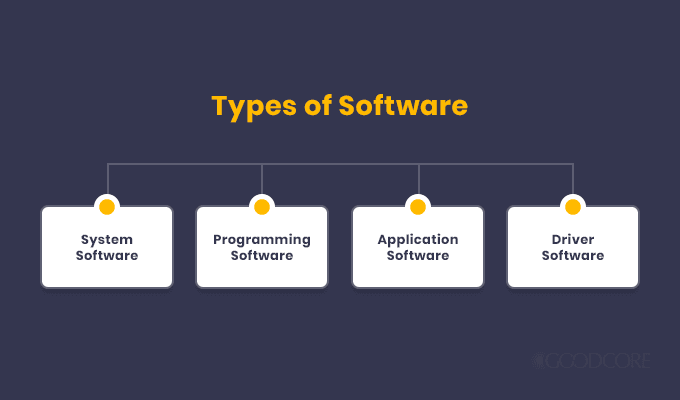
This image is property of cdn-galmn.nitrocdn.com.
Educational Software
Educational software encompasses tools and applications designed to facilitate learning and education. It includes learning management systems (LMS), language learning software, mathematics software, virtual reality (VR) learning software, and simulation software.
Learning Management Systems (LMS)
Learning management systems (LMS) are online platforms that facilitate the administration, delivery, and tracking of educational courses and training programs. They provide features for creating and organizing course content, managing student enrollment, facilitating communication, and assessing student performance. Prominent LMS platforms include Moodle, Blackboard, and Canvas.
Language Learning Software
Language learning software helps individuals acquire proficiency in foreign languages through interactive lessons, practice exercises, and language immersion activities. It provides tools for vocabulary building, grammar learning, pronunciation practice, and conversation simulations. Duolingo, Rosetta Stone, and Babbel are popular language learning software applications.
Mathematics Software
Mathematics software assists students and professionals in understanding and solving complex mathematical problems. It includes tools for symbolic calculations, graphing functions, solving equations, performing statistical analysis, and conducting mathematical simulations. Prominent mathematics software includes MATLAB, Mathematica, and Wolfram Alpha.
Virtual Reality (VR) Learning Software
Virtual reality (VR) learning software leverages immersive virtual environments to enhance the learning experience. It enables users to interact with simulated scenarios, explore virtual worlds, and engage in hands-on learning activities. VR learning software is employed in fields such as medical training, architecture, and vocational education.
Simulation Software
Simulation software allows users to create realistic simulations of real-world phenomena or systems. It enables the modeling and visualization of complex processes, facilitating experimentation and analysis. Simulation software is utilized in industries such as engineering, aerospace, healthcare, and gaming.
Entertainment Software
Entertainment software encompasses various forms of digital entertainment, including video games, multimedia software, animation software, digital art software, music production software, and virtual reality (VR) entertainment software.
Video Games
Video games are interactive software applications designed for entertainment purposes. They involve player engagement in gameplay, challenges, puzzles, and immersive virtual worlds. Video game software includes a diverse range of genres and platforms, catering to different audiences and preferences.
Multimedia Software
Multimedia software enables users to create, edit, and manage multimedia content, including images, videos, audio files, and animations. It provides tools for media editing, conversion, manipulation, and organization. Examples of multimedia software include Adobe Creative Cloud Suite, Corel multimedia software, and iMovie.
Animation Software
Animation software allows users to create and manipulate visual content to produce animated sequences or movies. It provides tools for creating 2D or 3D animations, character rigging, motion capture, and special effects. Prominent animation software applications include Autodesk Maya, Blender, and Adobe Animate.
Digital Art Software
Digital art software enables artists to create and modify digital artwork using various digital tools and techniques. It replicates traditional art mediums, such as drawing and painting, in a digital environment. Popular digital art software includes Adobe Photoshop, Corel Painter, and Procreate.
Music Production Software
Music production software assists musicians, composers, and producers in creating, recording, editing, and mixing music. It provides tools for composing melodies, arranging tracks, recording instruments, and applying digital audio effects. Leading music production software includes Ableton Live, Pro Tools, and FL Studio.
Virtual Reality (VR) Entertainment Software
Virtual reality (VR) entertainment software utilizes VR technology to deliver immersive and interactive entertainment experiences. It allows users to engage with virtual environments, explore virtual worlds, and participate in virtual activities. VR entertainment software includes games, interactive simulations, and virtual art experiences.
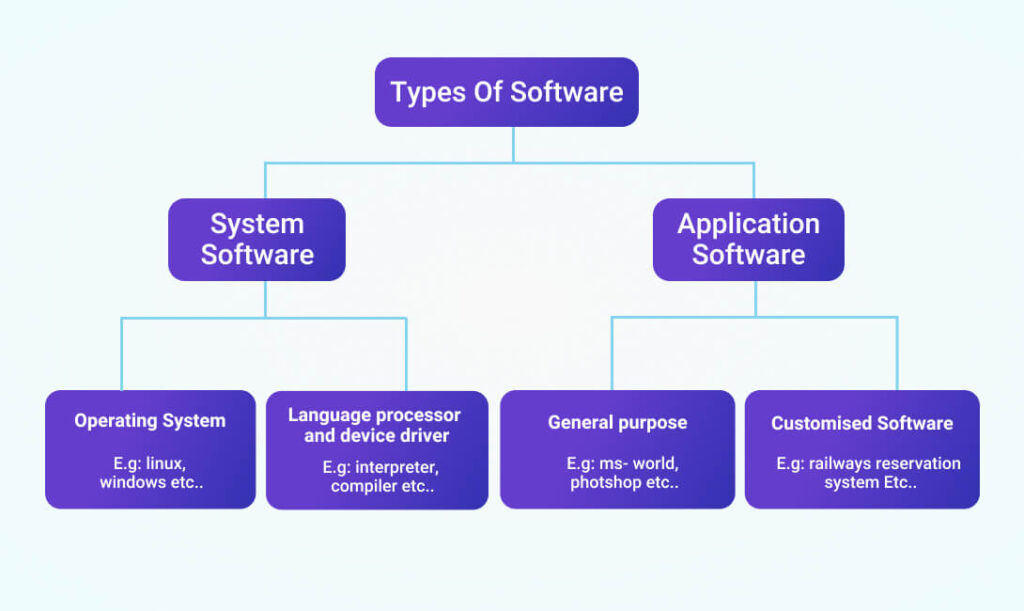
This image is property of www.openxcell.com.
Utility Software
Utility software comprises tools and applications that assist users in performing various maintenance and optimization tasks on their computer systems. It includes backup software, file compression software, disk cleanup software, data recovery software, and firewall software.
Backup Software
Backup software enables users to create copies of their files, documents, and data to protect against data loss. It automates the backup process, allowing for scheduled backups and incremental backups for efficient storage utilization. Popular backup software includes Acronis True Image, EaseUS Todo Backup, and Macrium Reflect.
File Compression Software
File compression software reduces the size of files and folders, making them easier to store, transfer, and share. It utilizes compression algorithms to pack multiple files into a single compressed file or archive. Widely used file compression software includes WinRAR, 7-Zip, and WinZip.
Disk Cleanup Software
Disk cleanup software assists users in optimizing the storage space on their computer systems by removing unnecessary files, temporary files, and other system clutter. It identifies and deletes redundant files, thus freeing up disk space and improving system performance. Examples of disk cleanup software are CCleaner, Wise Disk Cleaner, and BleachBit.
Data Recovery Software
Data recovery software helps retrieve lost, deleted, or inaccessible files from storage devices such as hard drives, solid-state drives (SSDs), and memory cards. It scans storage media for recoverable data, allows for selective file recovery, and repairs damaged or corrupted files. Prominent data recovery software includes Recuva, EaseUS Data Recovery Wizard, and Stellar Data Recovery.
Firewall Software
Firewall software protects computer systems from unauthorized access and malicious activities. It acts as a barrier between the internal network and external networks, monitoring incoming and outgoing network traffic. Firewall software prevents unauthorized access, blocks malicious content, and ensures network security. Well-known firewall software includes Norton Firewall, ZoneAlarm, and Windows Firewall.
Open Source Software
Open source software refers to software that is freely available and customizable, allowing users to access, modify, and distribute its source code. It includes various categories such as operating systems, office suites, web browsers, media players, image editing software, web development tools, and content management systems (CMS).
Operating Systems
Open source operating systems provide alternative choices to proprietary operating systems and allow users to customize and modify the system as per their requirements. Popular open source operating systems include Linux distributions (such as Ubuntu, Fedora, and CentOS), FreeBSD, and OpenBSD.
Office Suites
Open source office suites offer free alternatives to commercial office productivity software, providing tools for word processing, spreadsheets, presentations, and more. Examples of open source office suites are LibreOffice, OpenOffice, and Calligra Suite.
Web Browsers
Open source web browsers provide alternatives to proprietary web browsers, offering a free and customizable browsing experience. Well-known open source web browsers include Mozilla Firefox, Chromium (the open source version of Google Chrome), and Brave.
Media Players
Open source media players enable users to play various multimedia files, including audio and video. They often provide additional features and customization options. Notable open source media players include VLC media player, Kodi, and MPlayer.
Image Editing Software
Open source image editing software provides alternatives to commercial graphics software, allowing users to create, edit, and manipulate digital images. Well-known open source image editing software includes GIMP (GNU Image Manipulation Program), Krita, and Inkscape.
Web Development Tools
Open source web development tools facilitate the creation and maintenance of websites, web applications, and web content. They include software frameworks, libraries, and content management systems (CMS). Examples of open source web development tools are WordPress, Drupal, and Joomla.
Content Management Systems (CMS)
Open source content management systems (CMS) enable users to create and manage dynamic websites and digital content. They provide tools for content authoring, publishing, and editing, as well as website customization and administration. Popular open source CMS platforms include WordPress, Joomla, and Drupal.
In conclusion, the major types of software encompass a wide range of applications and serve various purposes. From system software that provides the essential infrastructure for computer operation, to application software tailored for specific tasks, to programming software used by developers, to enterprise software catering to the needs of large organizations, to embedded software powering specialized devices, to AI software enabling intelligent tasks, to educational software facilitating learning, to entertainment software providing digital amusement, to utility software assisting with maintenance and optimization, and to open source software providing free and customizable alternatives to commercial software, each type plays a vital role in the modern digital world. Understanding the different types of software and their functionalities is essential for navigating the vast software landscape and leveraging technology effectively.
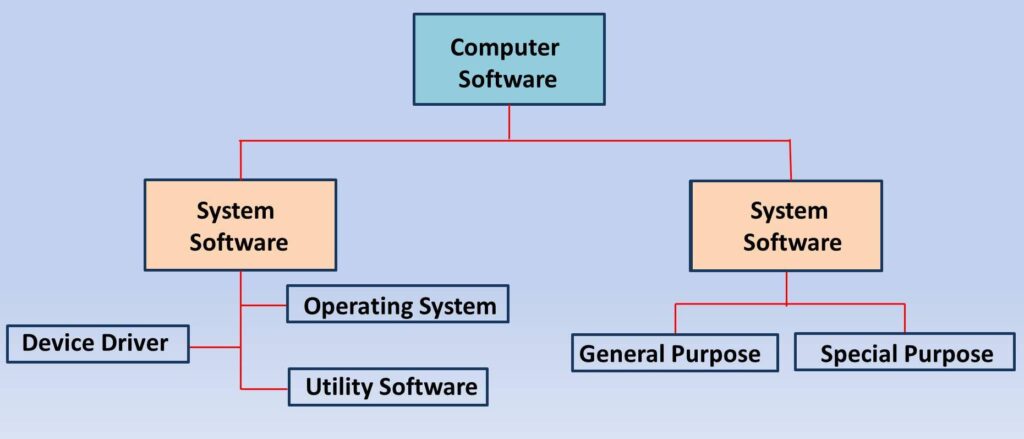
This image is property of mycomputernotes.com.
